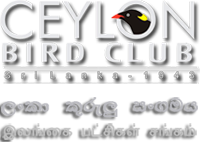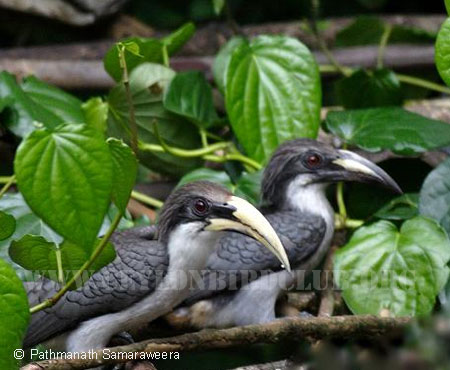


Ceylon Grey Hornbill Ocyceros gingalensis
(Sri Lanka Grey Hornbill)
Sinhalese - Kendetta
Tamil - Irattai - kondu- kuruvi
 The Grey Hornbill is a bird of forest and well wooded areas. It is found both in the wet and dry zones and ascends the hills up to about 1300 metres. In the Dry zone it favours riverine forests though in the Wilpattu National Park it inhabits forest close to the villus as well. It is a grotesque looking bird with an enormous decurved beak, long neck and long tail. Both sexes have similar plumage but the beak of the female is dark with a long cream patch on the upper mandible in contrast to the mostly pale yellow beak of the male. Young are similar to adults but have shorter beaks which are pale yellow, completely devoid of any black colour. Their irides too are grey in contrast to the red irides of adults. The Grey Hornbill generally occupies mid levels of forest and moves about in pairs, though flocks too are met with near fruiting trees. The food consists mostly of fruit but animal matter is also captured especially when young have to be fed. The call is a loud kaa, kaa, kaa. At times a continuous kak,kak,kak, kak,kak call is uttered.
The Grey Hornbill is a bird of forest and well wooded areas. It is found both in the wet and dry zones and ascends the hills up to about 1300 metres. In the Dry zone it favours riverine forests though in the Wilpattu National Park it inhabits forest close to the villus as well. It is a grotesque looking bird with an enormous decurved beak, long neck and long tail. Both sexes have similar plumage but the beak of the female is dark with a long cream patch on the upper mandible in contrast to the mostly pale yellow beak of the male. Young are similar to adults but have shorter beaks which are pale yellow, completely devoid of any black colour. Their irides too are grey in contrast to the red irides of adults. The Grey Hornbill generally occupies mid levels of forest and moves about in pairs, though flocks too are met with near fruiting trees. The food consists mostly of fruit but animal matter is also captured especially when young have to be fed. The call is a loud kaa, kaa, kaa. At times a continuous kak,kak,kak, kak,kak call is uttered.
Hornbills are well known for their remarkable nesting habits. The female chooses a natural cavity in a tree generally about six to ten metres from ground level and incarcerates herself by walling up the entrance with possibly her own droppings and sediment from the nest floor, leaving only a small vertical slit. The vertically flat beak is admirably suited to be used as a mason’s spoon to plaster the opening. The bird moves it up and down, vibrating it sideways at the same time to add and smoothen the walling up material. She moults her flight and tail feathers while inside.
The male feeds the imprisoned female at regular intervals .Ceylon Bird Club member Pathmanath Samaraweera, in Loris, December 1987 writes “This feeding process too was very interesting to watch. Usually the male would alight with a large fruit held delicately at the tip of his enormous beak. Having offered this to the female he would start regurgitating more fruit from his crop, moving his head up and down quite violently. One by one the fruits brought up would roll down to the tip of his beak, then to be passed on to the female.”
About a week before the young leave the nest, the female breaks the wall and emerges looking fresh in her newly moulted feathers as compared to the now bedraggled male. From then on, both birds feed the young. The breeding season is from April to about August. However a nest observed in Ratnapura was occupied from December till early March which may indicate that the breeding period may coincide with regional rainfall, the birds nesting during a time of less rain. Generally two or three white eggs are laid. The young are fed mostly with fruit but lizards, geckos, grasshoppers and cicadas are also brought to the nest.